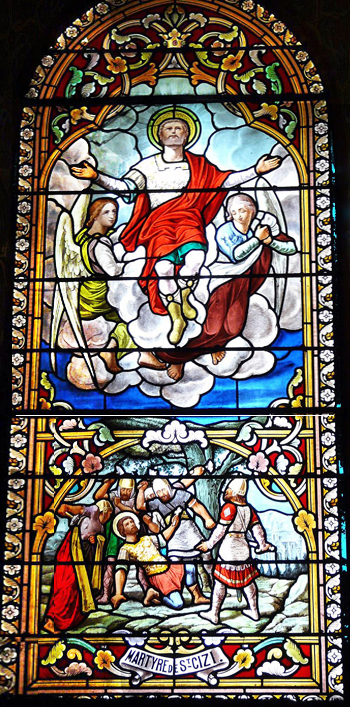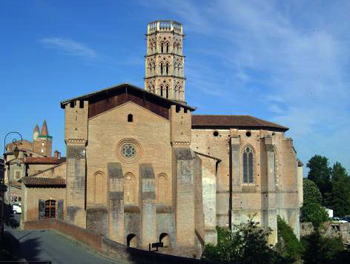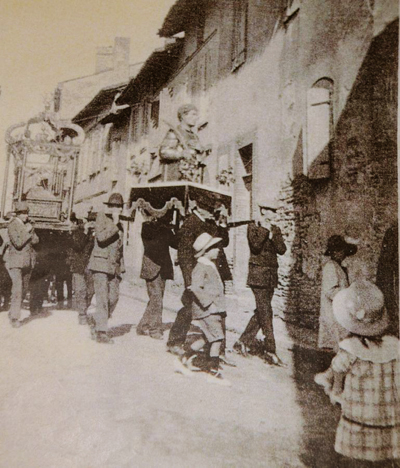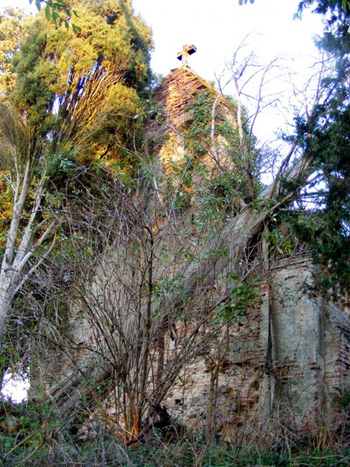 |
The Saint of the Day
St. Cizy de Besançon, August 16
Prof. Plinio Corrêa de Oliveira
Biographical selection:
In 778, after taking over Spain, the Saracens crossed the Pyrenees with an army of 40,000 and entered Gaul. They conquered a great part of the Septimania – a region in southern France – and reached the outskirts of Toulouse, constructing a great number of mosques along the Garonne River.

The window of St. Cizy’s martyrdom in the Cathedral of Rieux-Volvestre, below
 |
Among the warriors filled with faith, who joined together to expel these enemies of Christ from the Gascogne, Cizy of Besançon stood out. He was a descendent of the ancient Dukes of Bourgogne and was as famous for his piety as his military valor. The ancient records of his martyrdom affirm that, under his soldier’s armor, he wore austere dress, making him a man of great gravity and modesty.
Fulfilling all the duties of his Faith, he converted many of the unfaithful to the Catholic Church. In the tribunals of Charlemagne at which he assisted, Cizy addressed cases with amazing sagacity, even silencing the lawyers who were astounded at his competent application of the laws. Thus, he administered justice to all, giving each person his due, raising the admiration of those who witnessed it.
In combat he often succored his injured companions by miraculously healing their wounds.
This soldier of Christ received from Charlemagne the command of one-third of the knights who were defending the plains along the Garonne River. As the enemy advanced, Cizy readied the Catholic lines, inflaming his knights with these words:
“My companions in arms, fight courageously and you will win a celestial crown. Our enemies combat for earthly rewards, but we fight for an eternal glory. Do not be impressed by their numbers, but remember the prodigies the Lord has worked so many times against the infidels.”
Cizy advanced against the enemy with such ardor that he broke the heavy lines of the Saracens. Surrounded on all sides, he was taken prisoner. The enemies offered him to let him live if he would embrace the religion of Mahomet. He rejected the offer with scorn and, adoring Jesus Crucified in his heart, asked for martyrdom. The infidels turned their rage against him and smashed him with their war hammers.
The Catholic army, however, responded with even greater fury on hearing of the death of its chief. Not tarrying to take their revenge for its commander’s cowardly inflicted death, the knights attacked the Saracens, won the battle and filled the battlefield with their slaughtered corpses.
Charlemagne had a marble tomb raised on that site, which still today conserves the name of Cizy, and had the body of the martyr brought there to be buried. Afterwards, with the loot taken from the battle, he built a chapel where, by the grace of God, many miracles were worked through the intercession of the warrior saint. (Paul Guérin,
Les Petits Bollandistes Vies des Saints, Bar-le-Duc:Louis Guérin, 1873, pp. 633-634)
Comments of Prof. Plinio:
What is especially beautiful in the life of St. Cizy is the equilibrium between the apparently contradictory aspects of his personality.
On one hand, the soldier in those times, even more than today, was a rude man and, unfortunately, often not chaste. You see that St. Cizy was a great warrior and, at the same time, extremely pure, very pious and with excellent manners.
Charlemagne would have never put an army under St. Cizy’s command if he had not given proof of his military valor. Additionally, he had the virtues that were very difficult to practice in that state of life.

A procession through the streets of Rieux to honor its patron Saint Cizy |
On the other hand, the military spirit has a tendency to simplify questions by resolving them through force rather than arguments. You see that, despite this tendency, St. Cizy was a great warrior and a skillful lawyer who did not like to resolve by force what reason and talent could settle justly. He was a man who advocated the causes of persons in difficulty before the severe tribunal of Charlemagne.
Also, he was a man filled with compassion for the sick and cared for his wounded companions, often even working miraculous healings. He was, therefore, a man who at times would open the wounds of the enemies in the battlefield even while he closed the wounds of friends.
This contrast of qualities can confuse a mind unaccustomed to the polychromy of the Catholic mentality. In the harmony of these apparent contradictions, we find the splendor of the spirit of the Church.
This same man entered battle with such ardor that he broke the lines of the Saracens, found himself surrounded, and died defending the Faith. The most beautiful part is not just his death, but that soon afterwards, we are free to suppose, his soul, which left his body and entered celestial glory, appeared before God to beg His favor for his warriors so that a new wave of courage fell upon his cohorts, who lost no time in revenging his death.
After so many tremendous deeds of the warrior Cizy, we see the benevolence of his King, the future great Emperor, the grand Patriarch of all of Western Civilization, the man whose name is uttered with respect until today. Charlemagne ordered a marble tomb to be built, a significant act since in those areas marble was not readily available. He also ordered a chapel to be erected over the tomb, paid for with the loot of the enemy.
What a beautiful death for a Catholic warrior: to die with the admiration of his Emperor and his fellow warriors, with his body torn by the wounds the enemies made, with the glory earned by the enemies he had laid to rest. It is the death of a Christian warrior, a lawyer, a man of charity, a man of cultivated manners, a faithful soldier of Our Lord Jesus Christ.

Ruins of the ancient church of Saint Cizy in Rieux-Volvestre |
In this polychromy, in this play of opposite but harmonious aspects, a note of perfection and completeness enters that charms the onlooker. It shows us how the Catholic Church is profoundly holy in her teaching that souls must be perfect in virtues that are apparently opposite without being contradictory. It indicates the plethora of the common ground of all these virtues; a common ground that is the love of God. It is only a great love of God that can make a person so magnificent in the apparently opposite extremes of his personality. This is the extraordinary life of St. Cizy.
I cannot refrain from making another comment. Even before Paul VI dismissed many saints from the Calendar of Saints where they had remained for centuries, those who promote the school of sentimental piety had done something similar to many other saints.
Who of us have ever heard of St. Cizy? Who has heard eulogies of this magnificent life? And why have we heard nothing? It is because saints of this type were relegated to oblivion and silence. The combative saints were put in parentheses in order to present to the faithful exaggerated aspects of the goodness and mercy of others. This tactic prepared the Church for the progressivist and ecumenist mentality of our days.
Someone could ask me: Why do you insist on this point? I insist because I am afraid that if I do not, then in the Reign of Mary we will be invaded by optimism and will cease to be as vigilant as we must be. In the Reign of Mary, an even greater vigilance will be needed, for the inimucus homo [the enemy of man, the Devil] will be among us. He will plant just one small seed, but from that seed the entire last catastrophe will come and the downfall of the end times.
For this reason, I emphasize that when the Chastisement will end and the Reign of Mary will start, do not imagine that my first reaction will be to sing Gloria in excelsis Deo. It will be to seek after the enemies who still remain. Let the others sing; there are always lots of people ready to sing, but just a few waiting to fight with tenaciousness. We should be vigilant and combat relentlessly until History comes to an end. This is what we should desire.


  |
|
Prof. Plinio Corrêa de Oliveira | |
The Saint of the Day features highlights from the lives of saints based on comments made by the late Prof. Plinio Corrêa de Oliveira. Following the example of St. John Bosco who used to make similar talks for the boys of his College, each evening it was Prof. Plinio’s custom to make a short commentary on the lives of the next day’s saint in a meeting for youth in order to encourage them in the practice of virtue and love for the Catholic Church. TIA thought that its readers could profit from these valuable commentaries.
The texts of both the biographical data and the comments come from personal notes taken by Atila S. Guimarães from 1964 to 1995. Given the fact that the source is a personal notebook, it is possible that at times the biographic notes transcribed here will not rigorously follow the original text read by Prof. Plinio. The commentaries have also been adapted and translated for TIA’s site.
|
Saint of the Day | Home | Books | CDs | Search | Contact Us | Donate

© 2002- Tradition in Action, Inc. All Rights Reserved
|
 |

|